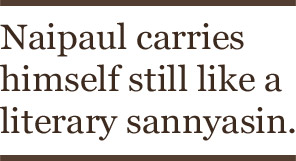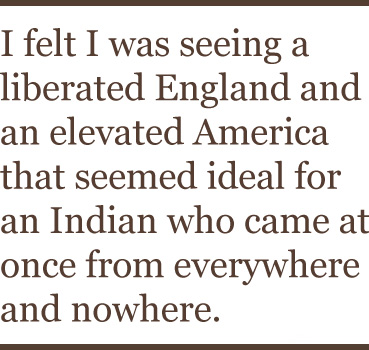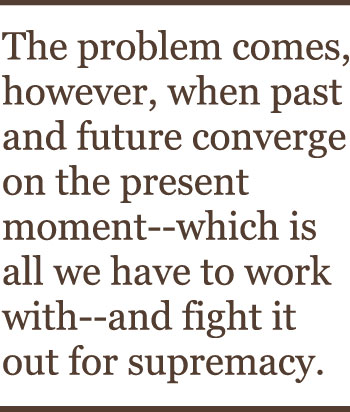We travel, initially, to lose ourselves; and we travel, next, to find ourselves. We travel to open our hearts and eyes and learn more about the world than our newspapers will accommodate. We travel to bring what little we can, in our ignorance and knowledge, to those parts of the globe whose riches are differently dispersed. And we travel, in essence, to become young fools again — to slow time down and get taken in, and fall in love once more. The beauty of this whole process was best described, perhaps, before people even took to frequent flying, by George Santayana in his lapidary essay, “The Philosophy of Travel.” We “need sometimes,” the Harvard philosopher wrote, “to escape into open solitudes, into aimlessness, into the moral holiday of running some pure hazard, in order to sharpen the edge of life, to taste hardship, and to be compelled to work desperately for a moment at no matter what.”
I like that stress on work, since never more than on the road are we shown how proportional our blessings are to the difficulty that precedes them; and I like the stress on a holiday that’s “moral” since we fall into our ethical habits as easily as into our beds at night. Few of us ever forget the connection between “travel” and “travail,” and I know that I travel in large part in search of hardship — both my own, which I want to feel, and others’, which I need to see. Travel in that sense guides us toward a better balance of wisdom and compassion — of seeing the world clearly, and yet feeling it truly. For seeing without feeling can obviously be uncaring; while feeling without seeing can be blind.
Yet for me the first great joy of traveling is simply the luxury of leaving all my beliefs and certainties at home, and seeing everything I thought I knew in a different light, and from a crooked angle. In that regard, even a Kentucky Fried Chicken outlet (in Beijing) or a scratchy revival showing of “Wild Orchids” (on the Champs-Elysees) can be both novelty and revelation: In China, after all, people will pay a whole week’s wages to eat with Colonel Sanders, and in Paris, Mickey Rourke is regarded as the greatest actor since Jerry Lewis.
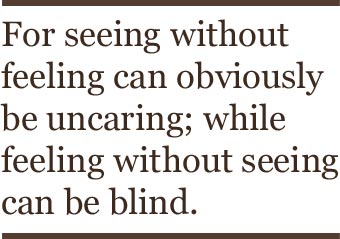
If a Mongolian restaurant seems exotic to us in Evanston, Ill., it only follows that a McDonald’s would seem equally exotic in Ulan Bataar — or, at least, equally far from everything expected. Though it’s fashionable nowadays to draw a distinction between the “tourist” and the “traveler,” perhaps the real distinction lies between those who leave their assumptions at home, and those who don’t: Among those who don’t, a tourist is just someone who complains, “Nothing here is the way it is at home,” while a traveler is one who grumbles, “Everything here is the same as it is in Cairo — or Cuzco or Kathmandu.” It’s all very much the same.
But for the rest of us, the sovereign freedom of traveling comes from the fact that it whirls you around and turns you upside down, and stands everything you took for granted on its head. If a diploma can famously be a passport (to a journey through hard realism), a passport can be a diploma (for a crash course in cultural relativism). And the first lesson we learn on the road, whether we like it or not, is how provisional and provincial are the things we imagine to be universal. When you go to North Korea, for example, you really do feel as if you’ve landed on a different planet — and the North Koreans doubtless feel that they’re being visited by an extra-terrestrial, too (or else they simply assume that you, as they do, receive orders every morning from the Central Committee on what clothes to wear and what route to use when walking to work, and you, as they do, have loudspeakers in your bedroom broadcasting propaganda every morning at dawn, and you, as they do, have your radios fixed so as to receive only a single channel).
We travel, then, in part just to shake up our complacencies by seeing all the moral and political urgencies, the life-and-death dilemmas, that we seldom have to face at home. And we travel to fill in the gaps left by tomorrow’s headlines: When you drive down the streets of Port-au-Prince, for example, where there is almost no paving and women relieve themselves next to mountains of trash, your notions of our global neighborhood and a “one world order” grow usefully revised. Travel is the best way we have of rescuing the humanity of places, and saving them from abstraction and ideology.
And in the process, we also get saved from abstraction ourselves, and come to see how much we can bring to the places we visit, and how much we can become a kind of carrier pigeon — a human Federal Express, if you like — in transporting back and forth what every culture needs. I find that I always take Michael Jordan posters to Kyoto, and bring woven ikebana baskets back to California; I invariably travel to Cuba with a suitcase piled high with bottles of Tylenol and bars of soap, and come back with one piled high with salsa tapes, and hopes, and letters to long-lost brothers.
But more significantly, we carry values and beliefs and news to the places we go, and in many parts of the world, we become walking video screens and living newspapers, the only channels that can take people out of the censored limits of their homelands. In closed or impoverished places, like Pagan or Lhasa or Havana, we are the eyes and ears of the people we meet, their only contact with the world outside and, very often, the closest, quite literally, they will ever come to Barack Obama or Taylor Swift. Not the least of the challenges of travel, therefore, is learning how to import — and export — dreams with tenderness.
By now all of us have heard (too often) the old Proust line about how the real voyage of discovery consists not in seeing new places but in seeing with new eyes. Yet one of the subtler beauties of travel is that it enables you to bring new eyes to the people you encounter. Thus even as holidays help you appreciate your own home more — not least by seeing it through a distant admirer’s eyes — they help you bring newly appreciative distant) eyes to the places you visit. You can teach them what they have to celebrate as much as you celebrate what they have to teach. This, I think, is how tourism, which so obviously destroys cultures, can also resuscitate or revive them, how it has created new “traditional” dances in Bali, and caused craftsmen in India to pay new attention to their works. If the first thing we can bring the Cubans is a real and balanced sense of what contemporary America is like, the second — and perhaps more important — thing we can bring them is a fresh and renewed sense of how special are the warmth and beauty of their country, for those who can compare it with other places around the globe.
Thus travel spins us round in two ways at once: It shows us the sights and values and issues that we might ordinarily ignore; but it also, and more deeply, shows us all the parts of ourselves that might otherwise grow rusty. For in traveling to a truly foreign place, we inevitably travel to moods and states of mind and hidden inward passages that we’d otherwise seldom have cause to visit.
On the most basic level, when I’m in Thailand, though a teetotaler who usually goes to bed at 9 p.m., I stay up till dawn in the local bars; and in Tibet, though not a real Buddhist, I spend days on end in temples, listening to the chants of sutras. I go to Iceland to visit the lunar spaces within me, and, in the uncanny quietude and emptiness of that vast and treeless world, to tap parts of myself generally obscured by chatter and routine.
We travel, then, in search of both self and anonymity — and, of course, in finding the one we apprehend the other. Abroad, we are wonderfully free of caste and job and standing; we are, as Hazlitt puts it, just the “gentlemen in the parlour,” and people cannot put a name or tag to us. And precisely because we are clarified in this way, and freed of inessential labels, we have the opportunity to come into contact with more essential parts of ourselves (which may begin to explain why we may feel most alive when far from home).
Abroad is the place where we stay up late, follow impulse and find ourselves as wide open as when we are in love. We live without a past or future, for a moment at least, and are ourselves up for grabs and open to interpretation. We even may become mysterious — to others, at first, and sometimes to ourselves — and, as no less a dignitary than Oliver Cromwell once noted, “A man never goes so far as when he doesn’t know where he is going.”
There are, of course, great dangers to this, as to every kind of freedom, but the great promise of it is that, traveling, we are born again, and able to return at moments to a younger and a more open kind of self. Traveling is a way to reverse time, to a small extent, and make a day last a year — or at least 45 hours — and traveling is an easy way of surrounding ourselves, as in childhood, with what we cannot understand. Language facilitates this cracking open, for when we go to France, we often migrate to French, and the more childlike self, simple and polite, that speaking a foreign language educes. Even when I’m SPEAKING {OMIT “NOT”} pidgin English in Hanoi, I’m simplified in a positive way, and concerned not with expressing myself, but simply making sense.
So travel, for many of us, is a quest for not just the unknown, but the unknowing; I, at least, travel in search of an innocent eye that can return me to a more innocent self. I tend to believe more abroad than I do at home (which, though treacherous again, can at least help me to extend my vision), and I tend to be more easily excited abroad, and even kinder. And since no one I meet can “place” me — no one can fix me in my RESUME –I can remake myself for better, as well as, of course, for worse (if travel is notoriously a cradle for false identities, it can also, at its best, be a crucible for truer ones). In this way, travel can be a kind of monasticism on the move: On the road, we often live more simply (even when staying in a luxury hotel), with no more possessions than we can carry, and surrendering ourselves to chance.
This is what Camus meant when he said that “what gives value to travel is fear” — disruption, in other words, (or emancipation) from circumstance, and all the habits behind which we hide. And that is why many of us travel not in search of answers, but of better questions. I, like many people, tend to ask questions of the places I visit, and relish most the ones that ask the most searching questions back of me: In Paraguay, for example, where one car in every two is stolen, and two-thirds of the goods on sale are smuggled, I have to rethink my every Californian assumption. And in Thailand, where many young women give up their bodies in order to protect their families — to become better Buddhists — I have to question my own too-ready judgments. “The ideal travel book,” Christopher Isherwood once said, “should be perhaps a little like a crime story in which you’re in search of something.” And it’s the best kind of something, I would add, if it’s one that you can never quite find.
I remember, in fact, after my first trips to Southeast Asia, more than a decade ago, how I would come back to my apartment in New York, and lie in my bed, kept up by something more than jet lag, playing back, in my memory, over and over, all that I had experienced, and paging wistfully though my photographs and reading and re-reading my diaries, as if to extract some mystery from them. Anyone witnessing this strange scene would have drawn the right conclusion: I was in love.
For if every true love affair can feel like a journey to a foreign country, where you can’t quite speak the language, and you don’t know where you’re going, and you’re pulled ever deeper into the inviting darkness, every trip to a foreign country can be a love affair, where you’re left puzzling over who you are and whom you’ve fallen in love with. All the great travel books are love stories, by some reckoning — from the Odyssey and the Aeneid to the Divine Comedy and the New Testament — and all good trips are, like love, about being carried out of yourself and deposited in the midst of terror and wonder.
And what this metaphor also brings home to us is that all travel is a two-way transaction, as we too easily forget, and if warfare is one model of the meeting of nations, romance is another. For what we all too often ignore when we go abroad is that we are objects of scrutiny as much as the people we scrutinize, and we are being consumed by the cultures we consume, as much on the road as when we are at home. At the very least, we are objects of speculation (and even desire) who can seem as exotic to the people around us as they do to us.
We are the comic props in Japanese home-movies, the oddities in MALINESE anecdotes and the fall-guys in Chinese jokes; we are the moving postcards or bizarre objets trouves that villagers in Peru will later tell their friends about. If travel is about the meeting of realities, it is no less about the mating of illusions: You give me my dreamed-of vision of Tibet, and I’ll give you your wished-for California. And in truth, many of us, even (or especially) the ones who are fleeing America abroad, will get taken, willy-nilly, as symbols of the American Dream.
That, in fact, is perhaps the most central and most wrenching of the questions travel proposes to us: how to respond to the dream that people tender to you? Do you encourage their notions of a Land of Milk and Honey across the horizon, even if it is the same land you’ve abandoned? Or do you try to dampen their enthusiasm for a place that exists only in the mind? To quicken their dreams may, after all, be to match-make them with an illusion; yet to dash them may be to strip them of the one possession that sustains them in adversity.
That whole complex interaction — not unlike the dilemmas we face with those we love (how do we balance truthfulness and tact?) — is partly the reason why so many of the great travel writers, by nature, are enthusiasts: not just Pierre Loti, who famously, infamously, fell in love wherever he alighted (an archetypal sailor leaving offspring in the form of Madame Butterfly myths), but also Henry Miller, D.H. Lawrence or Graham Greene, all of whom bore out the hidden truth that we are optimists abroad as readily as pessimists as home. None of them was by any means blind to the deficiencies of the places around them, but all, having chosen to go there, chose to find something to admire.
All, in that sense, believed in “being moved” as one of the points of taking trips, and “being transported” by private as well as public means; all saw that “ecstasy” (“ex-stasis”) tells us that our highest moments come when we’re not stationary, and that epiphany can follow movement as much as it precipitates it. I remember once asking the great travel writer Norman Lewis if he’d ever be interested in writing on apartheid South Africa. He looked at me astonished. “To write well about a thing,” he said, “I’ve got to like it!”
At the same time, as all this is intrinsic to travel, from Ovid to O’Rourke, travel itself is changing as the world does, and with it, the mandate of the travel writer. It’s not enough to go to the ends of the earth these days (not least because the ends of the earth are often coming to you); and where a writer like Jan Morris could, a few years ago, achieve something miraculous simply by voyaging to all the great cities of the globe, now anyone with a Visa card can do that. So where Morris, in effect, was chronicling the last days of the Empire, a younger travel writer is in a better position to chart the first days of a new Empire, post-national, global, mobile and yet as diligent as the Raj in transporting its props and its values around the world.
In the mid-19th century, the British famously sent the Bible and Shakespeare and cricket round the world; now a more international kind of Empire is sending Madonna and the Simpsons and Brad Pitt. And the way in which each culture takes in this common pool of references tells you as much about them as their indigenous products might. Madonna in an Islamic country, after all, sounds radically different from Madonna in a Confucian one, and neither begins to mean the same as Madonna on East 14th Street. When you go to a McDonald’s outlet in Kyoto, you will find Teriyaki McBurgers and Bacon Potato Pies. The placemats offer maps of the great temples of the city, and the posters all around broadcast the wonders of San Francisco. And — most crucial of all — the young people eating their Big Macs, with baseball caps worn backwards, and tight 501 jeans, are still utterly and inalienably Japanese in the way they move, they nod, they sip their Oolong teas — and never to be mistaken for the patrons of a McDonald’s outlet in Rio, Morocco or Managua. These days a whole new realm of exotica arises out of the way one culture colors and appropriates the products of another.
The other factor complicating and exciting all of this is people, who are, more and more, themselves as many-tongued and mongrel as cities like Sydney or Toronto or Hong Kong. I am, in many ways, an increasingly typical specimen, if only because I was born, as the son of Indian parents, in England, moved to America at 7 and cannot really call myself an Indian, an American or an Englishman. I was, in short, a traveler at birth, for whom even a visit to the candy store was a trip through a foreign world where no one I saw quite matched my parents’ inheritance, or my own. And though some of this is involuntary and tragic — the number of refugees in the world, which came to just 2.5 million in 1970, is now at least 27.4 million — it does involve, for some of us, the chance to be transnational in a happier sense, able to adapt anywhere, used to being outsiders everywhere and forced to fashion our own rigorous sense of home. (And if nowhere is quite home, we can be optimists everywhere.)
Besides, even those who don’t move around the world find the world moving more and more around them. Walk just six blocks, in Queens or Berkeley, and you’re traveling through several cultures in as many minutes; get into a cab outside the White House, and you’re often in a piece of Addis Ababa. And technology, too, compounds this (sometimes deceptive) sense of availability, so that many people feel they can travel around the world without leaving the room — through cyberspace or CD-ROMs, videos and virtual travel. There are many challenges in this, of course, in what it says about essential notions of family and community and loyalty, and in the worry that air-conditioned, purely synthetic versions of places may replace the real thing — not to mention the fact that the world seems increasingly in flux, a moving target quicker than our notions of it. But there is, for the traveler at least, the sense that learning about home and learning about a foreign world can be one and the same thing.
All of us feel this from the cradle, and know, in some sense, that all the significant movement we ever take is internal. We travel when we see a movie, strike up a new friendship, get held up. Novels are often journeys as much as travel books are fictions; and though this has been true since at least as long ago as Sir John Mandeville’s colorful 14th century accounts of a Far East he’d never visited, it’s an even more shadowy distinction now, as genre distinctions join other borders in collapsing.
In Mary Morris’s “House Arrest,” a thinly disguised account of Castro’s Cuba, the novelist reiterates, on the copyright page, “All dialogue is invented. Isabella, her family, the inhabitants and even la isla itself are creations of the author’s imagination.” On Page 172, however, we read, “La isla, of course, does exist. Don’t let anyone fool you about that. It just feels as if it doesn’t. But it does.” No wonder the travel-writer narrator — a fictional construct (or not)? — confesses to devoting her travel magazine column to places that never existed. “Erewhon,” after all, the undiscovered land in Samuel Butler’s great travel novel, is just “nowhere” rearranged.
Travel, then, is a voyage into that famously subjective zone, the imagination, and what the traveler brings back is — and has to be — an ineffable compound of himself and the place, what’s really there and what’s only in him. Thus Bruce Chatwin’s books seem to dance around the distinction between fact and fancy. V.S. Naipaul’s recent book, “A Way in the World,” was published as a non-fictional “series” in England and a “novel” in the United States. And when some of the stories in Paul Theroux’s half-invented memoir, “My Other Life,” were published in The New Yorker, they were slyly categorized as “Fact and Fiction.”
And since travel is, in a sense, about the conspiracy of perception and imagination, the two great travel writers, for me, to whom I constantly return are Emerson and Thoreau (the one who famously advised that “traveling is a fool’s paradise,” and the other who “traveled a good deal in Concord”). Both of them insist on the fact that reality is our creation, and that we invent the places we see as much as we do the books that we read. What we find outside ourselves has to be inside ourselves for us to find it. Or, as Sir Thomas Browne sagely put it, “We carry within us the wonders we seek without us. There is Africa and her prodigies in us.”
So, if more and more of us have to carry our sense of home inside us, we also — Emerson and Thoreau remind us — have to carry with us our sense of destination. The most valuable Pacifics we explore will always be the vast expanses within us, and the most important Northwest Crossings the thresholds we cross in the heart. The virtue of finding a gilded pavilion in Kyoto is that it allows you to take back a more lasting, private Golden Temple to your office in Rockefeller Center.
And even as the world seems to grow more exhausted, our travels do not, and some of the finest travel books in recent years have been those that undertake a parallel journey, matching the physical steps of a pilgrimage with the metaphysical steps of a questioning (as in Peter Matthiessen’s great “The Snow Leopard”), or chronicling a trip to the farthest reaches of human strangeness (as in Oliver Sack’s “Island of the Color-Blind,” which features a journey not just to a remote atoll in the Pacific, but to a realm where people actually see light differently). The most distant shores, we are constantly reminded, lie within the person asleep at our side.
So travel, at heart, is just a quick way to keeping our minds mobile and awake. As Santayana, the heir to Emerson and Thoreau with whom I began, wrote, “There is wisdom in turning as often as possible from the familiar to the unfamiliar; it keeps the mind nimble; it kills prejudice, and it fosters humor.” Romantic poets inaugurated an era of travel because they were the great apostles of open eyes. Buddhist monks are often vagabonds, in part because they believe in wakefulness. And if travel is like love, it is, in the end, mostly because it’s a heightened state of awareness, in which we are mindful, receptive, undimmed by familiarity and ready to be transformed. That is why the best trips, like the best love affairs, never really end.
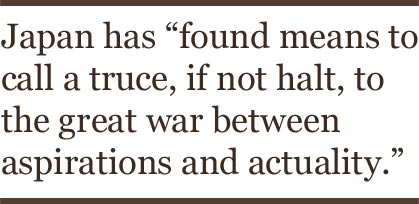 It is a haunting moment, and one that stands for a lifetime of such moments for those of us who find ourselves on this island of half-opened doors. It is made more touching by the fact that the girl knows she will never see the places that she dreams of; all her days will be spent in this forgotten town. And it is made more plangent by the fact that the foreigner confesses to himself (and to us) that the encounter is perplexing to him because he is “innocent despite experience”–and innocent not only because he sees no point in guilt. The plumbing of innocence and loneliness, the incarnation of a deeply Japanese freedom from cynicism and openness to wonder, the attentiveness to all the fine print, emotional and otherwise, in every fleeting moment are part of what make Donald Richie the most lasting and graceful foreign writer on Japan since Lafcadio Hearn (and before). He apprehends Japan (in all senses) on its own terms, yet puts it in a larger picture. He catches the sound of the sea through the mist, the fisherman’s no-nonsense explanation of how it will bring him a living, and then the sense of loss that is what the sound, and the explanation, mean. Japan keeps its visitors permanently enchanted–and vexed–Richie has told us, through its teasing mix of intimacy and distance; it is that same mix, brought to us through a companionable yet solitary traveler, utterly unguarded but always discreet, that gives his own prose its particular strength and beauty. The writing is open, unpretentious, immediate; yet entirely poised, unhurried, at peace with mystery.
It is a haunting moment, and one that stands for a lifetime of such moments for those of us who find ourselves on this island of half-opened doors. It is made more touching by the fact that the girl knows she will never see the places that she dreams of; all her days will be spent in this forgotten town. And it is made more plangent by the fact that the foreigner confesses to himself (and to us) that the encounter is perplexing to him because he is “innocent despite experience”–and innocent not only because he sees no point in guilt. The plumbing of innocence and loneliness, the incarnation of a deeply Japanese freedom from cynicism and openness to wonder, the attentiveness to all the fine print, emotional and otherwise, in every fleeting moment are part of what make Donald Richie the most lasting and graceful foreign writer on Japan since Lafcadio Hearn (and before). He apprehends Japan (in all senses) on its own terms, yet puts it in a larger picture. He catches the sound of the sea through the mist, the fisherman’s no-nonsense explanation of how it will bring him a living, and then the sense of loss that is what the sound, and the explanation, mean. Japan keeps its visitors permanently enchanted–and vexed–Richie has told us, through its teasing mix of intimacy and distance; it is that same mix, brought to us through a companionable yet solitary traveler, utterly unguarded but always discreet, that gives his own prose its particular strength and beauty. The writing is open, unpretentious, immediate; yet entirely poised, unhurried, at peace with mystery.


